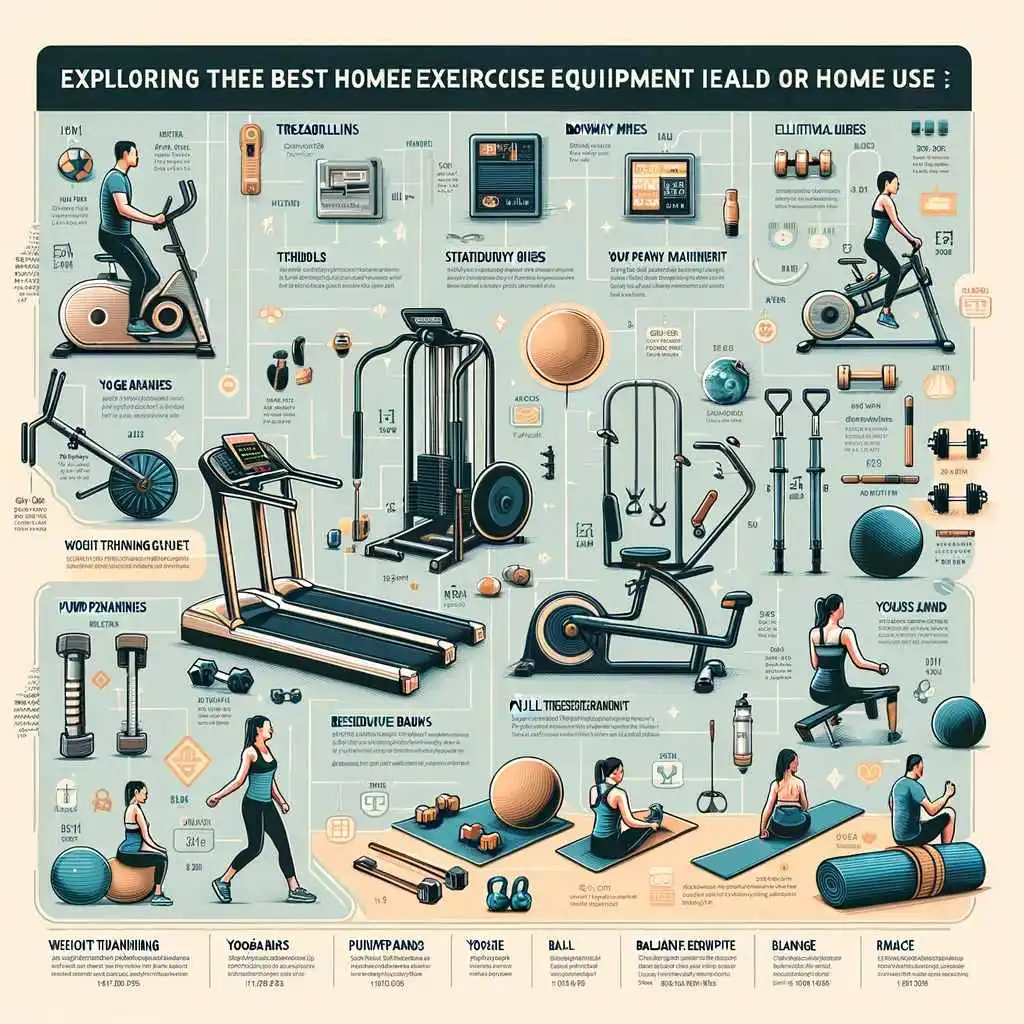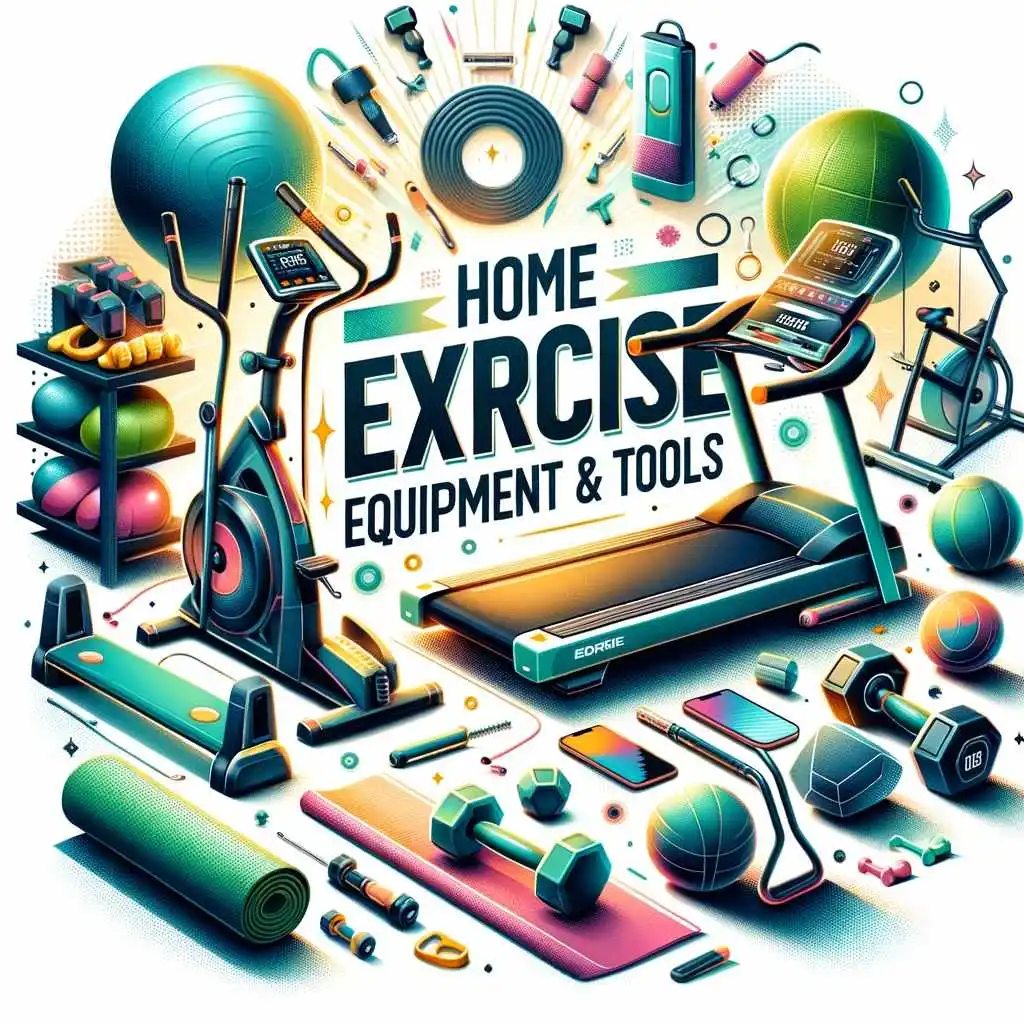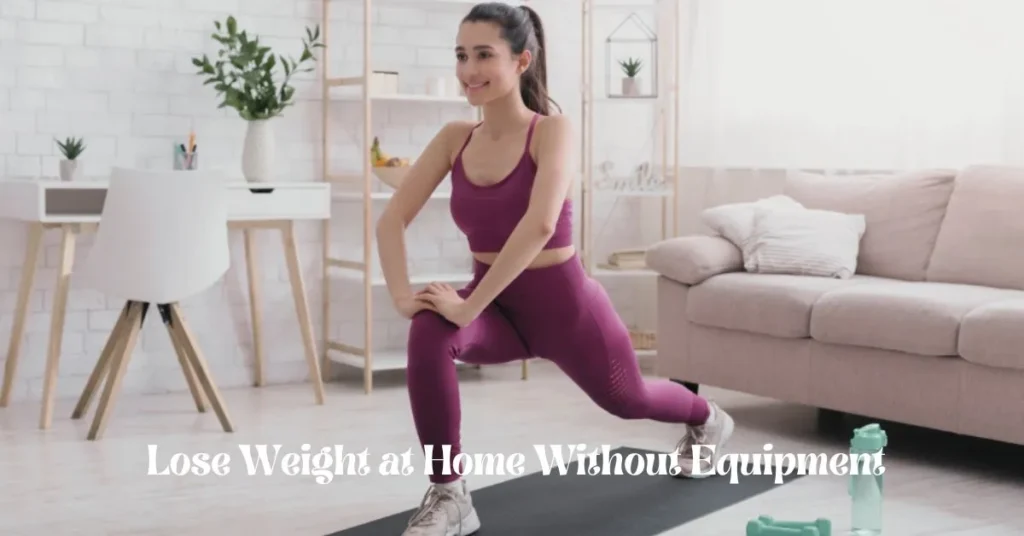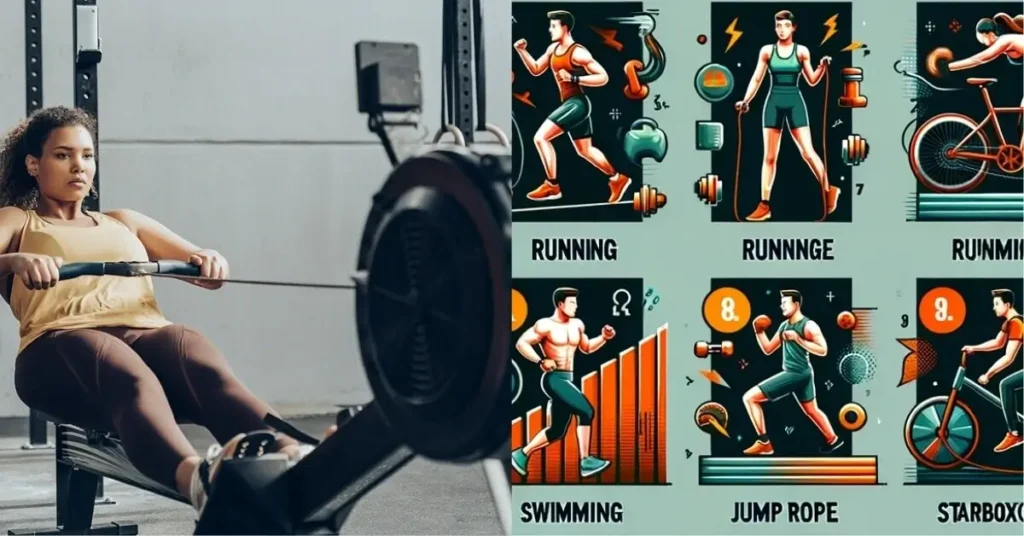Maintaining a consistent fitness routine can be challenging in today’s fast-paced world, especially for those struggling to visit a gym. This has led to a surge in the popularity of home gyms.
Building a home gym is a fantastic way to ensure you can work out conveniently, regardless of your schedule or external circumstances. This guide provides comprehensive insights into setting up an effective home gym. From choosing the best home exercise equipment to fit your space and budget to understanding the nuances of creating an effective workout routine, we cover all the essential aspects you need to know.
Whether you’re a fitness enthusiast or a beginner, this guide will help you navigate the journey of building your very own personal fitness haven. What: Best Home Exercise Equipment
Exploring Types of Best Home Exercise Equipment Ideal for Home Use

- Treadmills: Popular for cardio workouts, treadmills are versatile for walking, jogging, or running. It is ideal for those focusing on cardiovascular health and weight loss.
- Stationary Bikes: Excellent for low-impact cardio. They come in upright and recumbent forms, suitable for users with different fitness levels and space constraints.
- Elliptical Machines: Provide a full-body workout with less strain on the knees. Great for those seeking a low-impact cardio exercise.
- Rowing Machines: Effective for both cardio and strength training. Rowers work on various muscle groups and are beneficial for overall fitness.
- Weight Training Equipment: Includes dumbbells, barbells, kettlebells, and weight benches. Essential for strength training, muscle building, and toning.
- Resistance Bands: Versatile and space-saving, valid for various exercises targeting different muscle groups.
- Yoga Mats and Accessories: For flexibility, balance, and core strengthening exercises. Yoga mats, blocks, and straps are essentials for yoga and Pilates enthusiasts.
- Pull-up Bars: For upper body strength exercises, including pull-ups and chin-ups. They can be door-mounted or wall-mounted.
- Jump Ropes: A simple yet effective tool for cardiovascular fitness and coordination.
- Balance Equipment: StabilityStability balls and balance boards are helpful for core strengthening and stability exercises.
Comparison of Equipment Based on Effectiveness, Versatility, and User Preference
- Effectiveness: Cardio machines like treadmills and elliptical trainers are highly effective for calorie burning and endurance building. Weight training equipment is best for muscle building and strength training.
- Versatility: Resistance bands and weight training equipment offer a range of exercise options and can target multiple muscle groups. Ellipticals and rowing machines provide full-body workouts.
- User Preference: This varies greatly. Some prefer cardio-focused workouts with treadmills or stationary bikes, while others may favour strength training with weights. The choice often depends on personal fitness goals, health conditions, and enjoyment of the equipment.
- Space and Convenience: Equipment like foldable treadmills or compact stationary bikes are preferable for those with limited space. Resistance bands and jump ropes are ideal for easy storage and convenience.
- Budget: While treadmills and elliptical machines might be more expensive, resistance bands and jump ropes offer budget-friendly options.
The best home exercise equipment depends on individual needs, preferences, fitness goals, space availability, and budget. It’s important to choose equipment that not only aligns with your fitness objectives but also is enjoyable to use consistently.
How: Using Best Home Exercise Equipment Effectively
Tips and Tricks for Maximizing Workout Effectiveness
- Start with a Plan: Before beginning any exercise routine, have a clear plan. Define your fitness goals (e.g., weight loss, muscle building, improving endurance) and choose equipment that aligns with these goals.
- Consistency is Key: Regularity is more important than intensity. Aim for consistent, daily workouts rather than sporadic, intense sessions.
- Mix It Up: Avoid monotony and increase effectiveness by varying your workouts. If you have multiple pieces of equipment, use them on different days or combine them in a single workout.
- Proper Form and Technique: Learn how to use each piece of equipment correctly. This not only maximizes the effectiveness of your workout but also minimizes the risk of injury.
- Incremental Progression: Gradually increase the intensity of your workouts. Add more weight, resistance, or duration to challenge your body continually.
- Track Your Progress: Use a journal or fitness app to keep track of your workouts. Monitoring your progress can be a great motivator and help adjust your routine as needed.
- Rest and Recovery: Allow time for your body to rest and recover. Over-exercising can lead to burnout and injuries.
- Stay Hydrated and Eat Well: Proper nutrition and hydration significantly impact the effectiveness of your workout. Ensure a balanced diet and drink plenty of water.
- Engage in Compound Movements: Focus on exercises that target multiple muscle groups simultaneously, like squats, deadlifts, and bench presses, for comprehensive fitness.
- Create a Motivating Environment: Set up your home gym in a space that motivates you. Good lighting, ventilation, and music can create an encouraging workout environment.
Guidance on Setting Up a Routine or Workout Plan
- Identify Your Goals: Whether it’s building strength, losing weight, or improving cardiovascular health, your goals will dictate the structure of your routine.
- Balance Your Workouts: Include a mix of cardio, strength training, and flexibility exercises. Balance is crucial for overall fitness and injury prevention.
- Schedule Your Workouts: Designate specific times for your workouts and stick to them. Treat these as non-negotiable appointments.
- Start Slow: If you’re new to exercising, start with shorter, less intense sessions and gradually build up.
- Incorporate Rest Days: Plan rest days to allow your body to recover. This is crucial for muscle growth and avoiding overuse injuries.
- Adjust as Needed: Be flexible and willing to adjust your routine based on your progress and any changes in your lifestyle or fitness level.
- Seek Professional Advice: Consult a fitness trainer to create a personalized and safe workout plan, especially if you have specific health concerns or fitness goals.
Following these tips and setting up a well-thought-out routine, you can effectively use your home exercise equipment to achieve your fitness goals.
Where: Setting Up Your Home Gym
Ideas for Creating a Workout Space in Different Types of Homes

Small Apartments:
- Vertical Storage: Use wall mounts for equipment like bikes or resistance bands.
- Foldable Equipment: Opt for compact, foldable items like treadmills or yoga mats that can be easily stored under a bed or in a closet.
- Corner Setup: Utilize an unused corner for a mini-gym setup, focusing on space-saving equipment.
Houses with Spare Rooms:
- Dedicated Gym Room: Transform a spare room into a gym with diverse equipment.
- Flooring: Consider installing rubber or foam flooring for comfort and equipment protection.
- Mirrors: Add mirrors to monitor form and create a more spacious feel.
Houses with Garages or Basements:
- More extensive Equipment Setup: These spaces are ideal for heavier equipment like weight benches or large cardio machines.
- Climate Control: Ensure proper ventilation and heating/cooling for comfort.
Outdoor Spaces:
- Weatherproof Equipment: Use weather-resistant equipment for outdoor setups in gardens or patios.
- Covered Areas: Utilize a canopy or shaded area to protect against the elements.
Space Requirements and Placement Tips for Various Equipment
Cardio Machines (Treadmills, Bikes, Ellipticals):
- Space: Allow at least 20-30 square feet for these machines.
- Placement: Ensure enough clearance around the machine for safe use and maintenance.
Weight Training Equipment:
- Space: Plan for about 35-50 square feet for a bench and weights.
- Organization: Use weight racks to organize and save space.
Yoga and Flexibility Area:
- Space: A small area of about 10-20 square feet is sufficient.
- Environment: Choose a calm, quiet spot with room for stretching.
High-Intensity Interval Training (HIIT):
- Space: A clear floor area of about 20 square feet for movements like jumping jacks or burpees.
- Equipment: Keep equipment like kettlebells or jump ropes easily accessible.
Safety and Comfort:
- Flooring: Use protective flooring to reduce noise and cushion impact.
- Ventilation: Ensure good air circulation, especially in enclosed or small spaces.
- Lighting: Bright, clear lighting helps maintain energy levels and ensure safety.
Multifunctional Spaces:
- For multipurpose rooms, consider modular or transformable equipment.
- Use room dividers or furniture that can be easily moved to create a temporary workout space.
Creating an effective home gym depends on the type of home and available space. By utilizing space smartly and choosing the right equipment, you can create a functional and motivating workout area regardless of your living situation.
When: Best Times for Home Workouts
Advantages of Scheduling Workouts at Home
- Flexibility: Home workouts can be scheduled anytime, offering flexibility to fit into various lifestyles, whether you’re an early bird or a night owl.
- Time-Saving: No time is wasted commuting to and from a gym, making it easier to fit workouts into a busy schedule.
- Privacy and Comfort: Working out at home offers privacy, allowing you to exercise without self-consciousness or distractions.
- Customization: You can tailor your workout environment to your preferences, such as music, temperature, and equipment setup.
- Family Involvement: Home workouts can involve family members, promoting a healthy lifestyle for everyone.
How to Integrate Home Workouts into a Busy Schedule
- Set a Routine: Consistency is critical. Schedule your workouts like any other necessary appointment.
- Short and Effective Workouts: Opt for high-intensity interval training (HIIT) or circuit training, which can be completed in a shorter time but are highly effective.
- Combine Activities: Incorporate exercise into other activities, like doing squats while watching TV or a yoga session during a work break.
- Morning Workouts: Starting your day with a workout can boost energy levels and ensure you exercise before the day gets busy.
- Use Technology: Fitness apps and online workouts can provide guided exercises within a specific time frame, making it easier to stay on track.
10 Best Home Exercise Equipment & Tools for 2024

- Adjustable Dumbbells: Space-saving and versatile for a range of strength exercises.
- Foldable Treadmill: Ideal for cardio workouts, especially in small spaces.
- Stationary Bike with Virtual Training: Offers an immersive cycling experience with online classes and scenic routes.
- Smart Rowing Machine: Combines strength and cardio with technology to track performance.
- Resistance Band Set: For full-body workouts, lightweight and perfect for flexibility training.
- Yoga Mat with Alignment Marks: Essential for yoga or Pilates, with guides for proper alignment.
- Kettlebell Set: Ideal for strength training and functional workouts.
- Pull-up Bar: This can be fitted in a doorway for upper body workouts.
- Balance Ball: Useful for core exercises, stability training, and stretching.
- Virtual Reality Fitness System: An emerging trend offering an interactive and fun way to work with virtual reality games and exercises.
These equipment choices cater to various fitness levels and goals, from basic strength training to advanced cardio workouts, and can be integrated into different home environments.
Factors to Consider When Building Your Home Gym
Space:
- Assess the amount of space available in your home for gym equipment.
- Consider foldable or multifunctional equipment if space is limited.
Budget:
- Determine your budget for home gym equipment.
- Remember that higher-priced items often offer better quality and durability, but weigh this against your needs and usage.
Personal Fitness Goals:
- Your fitness goals (cardiovascular health, strength training, flexibility, etc.) will dictate your needed equipment.
- Choose equipment that aligns with your current fitness level and future goals.
Equipment Versatility:
- Opt for equipment that can be used for multiple exercises and targets different muscle groups.
- Versatile equipment is cost-effective and space-saving.
Maintenance:
- Consider the maintenance requirements of the equipment.
- Choose equipment that is easy to clean and requires minimal regular maintenance.
Safety Considerations:
- Ensure the equipment has safety features, especially if working out alone.
- Check for stability, secure grips, and non-slip surfaces.
Ergonomic Design:
- Equipment should be ergonomically designed to prevent injury and ensure comfort.
- Look for adjustable settings to tailor the equipment to your body size and shape.
How We Chose
Comprehensive Research:
- We conducted extensive research, including market surveys and analysis of fitness trends.
Customer Reviews:
- Customer feedback was heavily weighted, as it provides real-world usage insights.
- Reviews can highlight pros and cons not immediately evident.
Expert Opinions:
- Consultations with fitness professionals and trainers helped me understand the effectiveness and practicality of different equipment.
Product Testing:
- Hands-on testing assessed build quality, ease of use, and the workout experience.
Versatility and Functionality:
- We prioritized equipment that offers multiple workout options and is suitable for various fitness levels.
Value for Money:
- The cost-to-benefit ratio was a significant consideration, ensuring affordability without compromising quality.
Best Home Exercise Equipment FAQs
What are the key factors to consider before purchasing home exercise equipment?
Key factors include your fitness goals, space availability, budget, equipment versatility, and maintenance requirements.
How do I ensure the equipment is durable?
Look for equipment made from high-quality materials, check warranty terms, and read user reviews focusing on long-term use.
What should I know about warranties and return policies?
Understand the length of the warranty, what it covers, and the return policy details, including any restocking fees or shipping costs.
Is investing in multifunctional equipment or specific machines for each exercise better?
This depends on your fitness goals and space. Multifunctional equipment saves space and budget, but specific machines might be necessary for targeted fitness goals.
How can I maintain and clean my home gym equipment?
Regular cleaning with appropriate products, routine inspections for wear and tear, and following the manufacturer’s maintenance guidelines are crucial.
Can home exercise equipment be as effective as gym machines?
Yes, with the right equipment and workout routine, you can achieve fitness goals as effectively as in a gym.
How do I choose the right size equipment for my home?
Measure your available space and compare it with the equipment dimensions, considering additional space for movement around it.
Conclusion
Setting up a home gym is a journey that requires careful consideration of various factors such as space, budget, personal goals, and safety. By choosing the right equipment, understanding how to use it effectively, and integrating it into your daily routine, you can create a personalized and efficient workout environment.
The convenience and customization of a home gym can significantly enhance your fitness journey, making it more enjoyable and sustainable. Remember, the key to a successful home gym is not just in the equipment you choose but in the commitment to your health and fitness goals.
With this comprehensive guide, you’re now equipped with the knowledge to make informed decisions and take the first steps towards a healthier, fitter you right in the comfort of your home.


